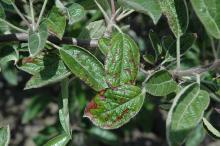Cause Isolation attempts typically find different saprophytic fungi associated with the necrotic tissue. Fewer necrotic spot symptoms have been associated with some fungicides, indicating a fungal cause to the problem. Alternaria alternata, Stemphyllium, and Aureobasidium have been among the fungi recovered in western Oregon. Additional observations have detected Venturia inaequalis conidia in the center of several spots. It has been suggested that the spots are "burned out" scab lesions that other fungi have since colonized and expanded. Burned out meaning that the scab fungus has colonized the tissue but then subsequently killed due to fungicide use. Other theories include a hypersensitive reaction to rust infection again followed by colonization by saprophytic fungi. The ability of A. alternata to incite these lesions has also been suggested. This problem is different from Golden Delicious necrotic leaf blotch. This problem has been observed in western Oregon and Hood River production areas. The Rome cultivar seems to develop these unusual spots in many areas of the United States. In western Oregon, it is seen on cultivars Rome and Golden Delicious apples and less so on cultivars Braeburn, Jonathan, or Red Delicious. Severe some years and almost nonexistent other years but generally of minor concern.
Symptoms Discrete necrotic round spots develop on leaves in late spring and early summer. Spots are typically a half-inch in size, light brown with a thin dark purple border. Spots are seen on both sides of the leave in the same location (in contrast to apple scab which is seen on only one side or the other). Smaller spots may be more purple than brown. Larger spots may have broader purple borders and seem less circular. Symptoms are similar to both frogeye leaf spot as well as Alternaria blotch.
Control In most years, control is not needed.

